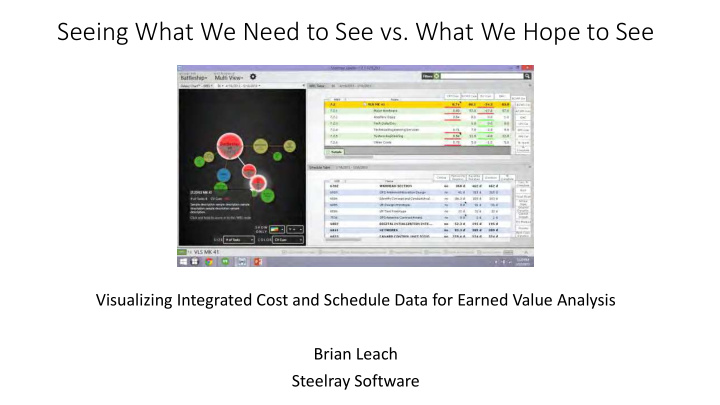



Seeing What We Need to See vs. What We Hope to See Visualizing Integrated Cost and Schedule Data for Earned Value Analysis Brian Leach Steelray Software
Objectives • Review the Purpose of Visualization, especially as it pertains to EVM Analysis • Discuss the issues and obstacles that impede EVM Visualization • Review progress on overcoming the issues and obstacles • Discuss how cost and schedule data can be integrated • Review some examples of reports and views • Discuss the future of EVM Visualization
What is Visualization? From The Visual Display of Quantitative Information , by Edward Tufte: • “Visually display measured quantities by means of the combined use of points, lines, a coordinate system, numbers, symbols, words, shading, and color.” • It is a relatively old or recent invention, depending on your perspective. • Statistical graphics weren’t used until 1750 – 1800. • The study of visualization – what works and what doesn’t work -- is much more recent, taking place in the past few decades.
What is Good Visualization? Statisticians and analysts have a simple success criteria, stated by Nathan Yau : “If a graphic or interactive doesn’t help in analysis, then it’s not useful. It’s a failure.” • More reading: Visualize This: The FlowingData Guide to Design, Visualization, and Statistics
Earned Value Visualization • Earned Value Data comes from multiple sources. • The project performance measurement plan (the planned value) is typically found in the project’s scheduling system. • The earned value must be measured against the planned value and is also typically found in the scheduling system. • Actual costs are taken into account, and these typically are found in the project’s cost system.
One of the main purposes of earned value is to provide an “early warning” buzzer that sounds in the early phases of a project, when it is not too late for corrective action to be taken to avoid serious cost overruns.
The Problem: Software Silos TEAM COST IMS PLAN
The Problem: Software Silos TEAM PLAN
Conversion and Export/Import
Historical Progress From the October 2006 DoD EVM Implementation Guide : • 2.2.5.5.2 Electronic Data Interchange (EDI) . The use of electronic media is required for all reports unless disclosure of this information would compromise national security. All data should be in a readable digital format (e.g., pdf files are not acceptable). The ANSI X12 standard (839 transaction set), the United Nations Electronic Data Interchange for Administration, Commerce and Transport (UN/EDIFACT) standard (PROCST message), or the XML equivalent are the accepted formats. On-line access to the data may be provided to augment formal submission. Requirements to submit reports by electronic means are included in the CDRL. If technology is not available to support X12 or XML IMS data submission, the IMS should be delivered electronically in the native digital format.
Stalled Progress • Initially, DoD developed and issued an ANSI X12 standard for earned value management (EVM) but no agreement was reached to normalize schedule planning and execution information across disparate proprietary software applications. • For years, attempts were met both by industry skepticism and resistance from software vendors.
Historical Progress • In 2010, the NDIA PMSC (National Defense Industrial Association’s Program Management Systems Committee) worked on breaking the stalemate. • In 2012, after working with major contractors, DoD agencies, and vendors on an XML standard, a consensus was reached and the XML standard accepted by DoD’s Performance Assessments and Root Cause Analyses (PARCA) office.
Historical Progress July 1, 2012: PARCA releases the IPMR DID • The IPMR DID combines the CPR and IMS DIDs. Why? To emphasize the integration of the schedule and cost data for performance reporting. • The electronic data delivery format for the OSD EVM Central Repository changes from the ANSI X12 standard to the UN/CEFACT XML standard.
Integration! Cost Schedule
Integration! The XML cost data contains a tree of WBS elements with an ID representing the WBS code.
Integration! In Format 6 (the XML version of the IMS): <ProjectScheduleTask> 1 <WorkPackageID>wbs code</WorkPackageID> <ControlAccountID>wbs code</ControlAccountID> 2 <DataNodeID>wbs code</DataNodeID> 3 : : </ProjectScheduleTask>
Vendors Respond From 2012 to the present, vendors supported exporting the IPMR standard, including: • Microsoft (provided by Steelray) • Deltek – support in several products • Steelray • Encore Analytics • Strategic Network Analysis (SNA) • Oracle – (still in development)
What does integration look like?
Value Delivery There is strong business value in the analysis of their integration. • With earned value systems, along with any tracking and control system, the big picture must be considered. One of the key questions to ask and concepts to clarify is the around the business value that the system delivers. • The same holds true for the visualization of earned value data. If the visualization and the analysis that it supports doesn’t bring significant incremental business value, it is probably not worth the effort. For example, it should be fairly easy to show that the same analysis can be done more quickly or a more thorough analysis can be done in the same amount of time. • Insights may become visible that previously would have been difficult or impossible to uncover.
The Next Wave • Integrated packages • New Views • Metadata and The Third Dimension – Z(oom) • The Fourth Dimension - Time
Thank You! Contact Info: • brian.leach@steelray.com • www.steelray.com
Recommend
More recommend